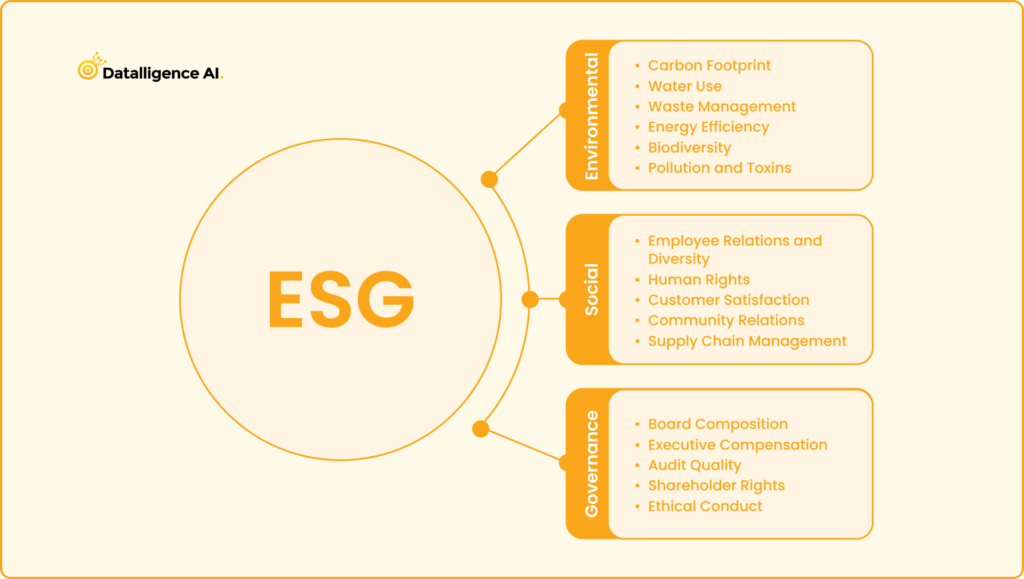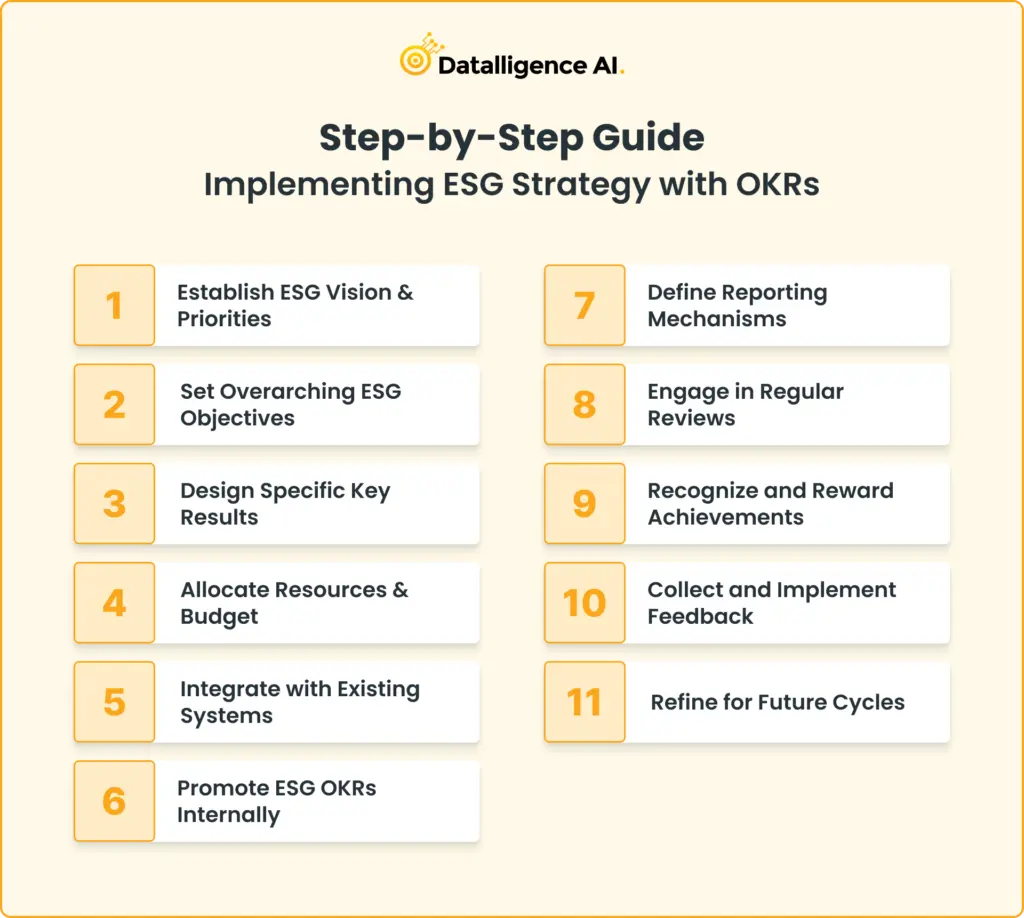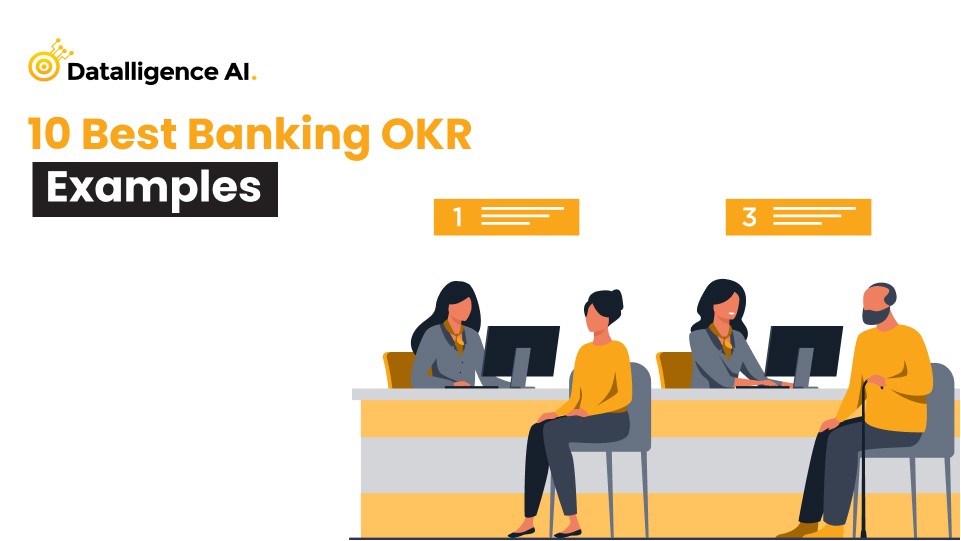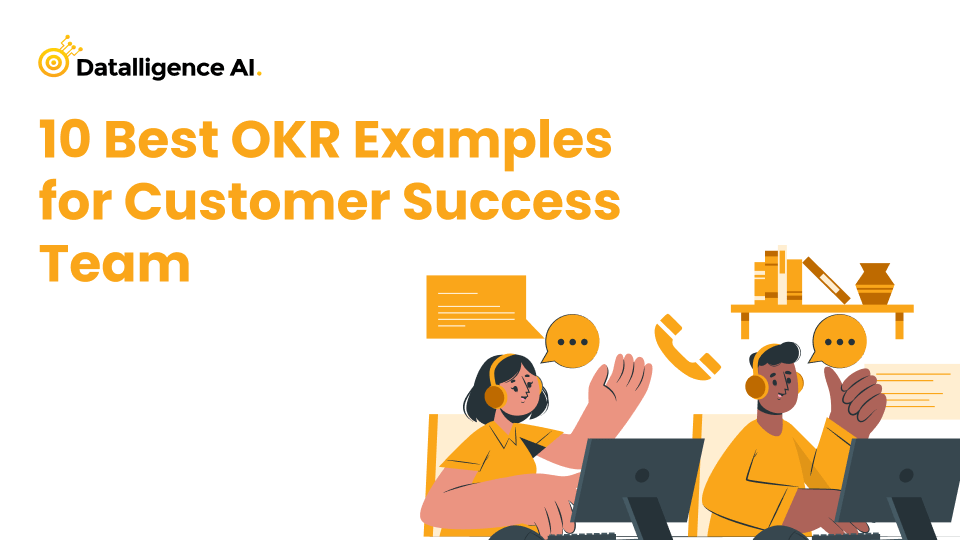The conversation around corporate responsibility has significantly shifted in recent years. Companies are no longer only judged by their profit margins, but also by how they impact the environment, how they treat their employees, and their role in the larger societal framework. One framework that has been gaining traction is the implementation of ESG (Environmental, Social, and Governance) strategies. This paradigm shift requires businesses to integrate sustainable practices, be it ecological conservation or fostering social equity, into their core objectives.
But how do companies effectively set, track, and achieve these high-reaching ESG goals? This is where the concept of integrating an ESG strategy with OKRs comes into play. In this blog, we’ll explore how OKRs can effectively aid businesses in implementing their ESG strategies and why it’s a game-changer in corporate sustainability.
Table of Contents
What is ESG?

ESG stands for Environmental, Social, and Governance. It represents a set of standards that businesses and investors use to evaluate corporate behavior and determine the future financial performance of companies. Through ESG, companies are assessed based on their commitment to sustainability, ethical practices, and societal impact.
The three pillars encompass a wide range of factors:
Environmental:
- Carbon Footprint
- Water Use
- Waste Management
- Energy Efficiency
- Biodiversity
- Pollution and Toxins
Social:
- Employee Relations and Diversity
- Human Rights
- Customer Satisfaction
- Community Relations
- Supply Chain Management
Governance:
- Board Composition
- Executive Compensation
- Audit Quality
- Shareholder Rights
- Ethical Conduct
By adhering to ESG standards, businesses can demonstrate responsibility beyond just profit, addressing the broader impacts they have on the world.
Why is ESG crucial for businesses?
ESG has become a cornerstone for modern businesses, and its importance cannot be understated. At its core, ESG embodies the broader responsibilities businesses have beyond mere profitability.
Here’s why it’s crucial
- Helping companies identify and mitigate operational and reputational risks, thereby safeguarding their long-term interests.
- Aligning businesses with the evolving values and expectations of informed consumers, employees, and investors, can foster deeper brand loyalty and trust.
- Enhancing long-term profitability by stimulating innovation, optimizing resources, and tapping into emergent market opportunities.
- Ensuring businesses remain resilient, adaptive, and future-ready amidst a backdrop of global challenges like climate change, social inequalities, and evolving governance standards.
- Attracting investments, as many institutional investors are prioritizing ESG-compliant businesses due to their perceived sustainability and reduced risk profile.
- Promoting a holistic approach to corporate performance, where success isn’t just measured by financial metrics but also by positive societal and environmental impact.
Incorporating ESG practices positions companies for sustainable success in today’s interconnected world.
How OKRs and ESG Strategy Corelate
OKRs and ESG strategies can be seamlessly integrated to enhance an organization’s path toward sustainable and accountable operations.
- Firstly, integrating OKRs (Objectives and Key Results) with ESG (Environmental, Social, and Governance) strategies allows companies to align their overarching strategic vision with tangible ESG goals, making sustainability a measurable and accountable objective. Every initiative can be tracked, ensuring that ethical and sustainable practices are not just theoretical but actionable.
- Secondly, the dynamic nature of OKRs, which are often revisited and refined, means that ESG strategies remain flexible and responsive. This adaptability is essential in a rapidly changing world, where new sustainability challenges and opportunities can emerge swiftly.
- Furthermore, by embedding ESG objectives within OKRs, companies foster a heightened sense of collaboration across departments, deepen employee engagement with a clear sense of purpose, and instill a culture of continuous improvement, ensuring that sustainability remains at the heart of organizational progress.
Why use OKRs for ESG strategy?
Every effective ESG strategy must start with specific goals (we’ll talk more about this later). To implement a strategy as effectively as possible, OKRs can help choose the best ones from among the many topics and potential goals.
Use OKRs as a strategic framework for ESG initiatives, there are four main arguments in favor of doing so:
Driving Ambitious ESG Change with OKRs
While many companies set ESG goals, the key is to aim for transformative change rather than minor improvements. OKRs promote setting audacious objectives, challenging organizations to strive beyond incremental ESG advancements and instead, eye transformative shifts that can have larger-scale impacts.
Unified Focus and Alignment
An ESG strategy is only as effective as its execution. OKRs, by design, rally everyone in the organization around a set of shared objectives. This ensures that, from top management to the frontline employee, everyone is synchronized in pushing towards realizing ESG initiatives.
Bridging the Strategy-Execution Divide
Often, there’s a chasm between what a company plans in its strategy rooms and what gets implemented on the ground. OKRs act as a bridge, providing a clear roadmap from strategy formulation to tangible outcomes. Companies can ensure their ESG vision is translated into meaningful actions by continuously tracking key results.
Adapting to a Changing Landscape
The world of sustainability is dynamic, with new challenges and opportunities emerging regularly. OKRs offer organizations the agility to pivot their ESG strategies in response to real-world feedback and changing circumstances. This adaptability ensures that companies remain responsive and proactive in their sustainable endeavors.
Benefits of Implementing ESG with OKRs

- Vision Alignment
- Measurable Outcomes
- Cross-Functional Collaboration
- Enhanced Accountability
- Strategic Agility
- Employee Engagement
- Strategy-Execution Bridge
- Ambitious Targeting
- Iterative Improvement
- Stakeholder Trust
Step-by-Step Guide: Implementing ESG Strategy with OKRs

STEP 1: Establish ESG Vision & Priorities
- Start with a broad vision of where you want your company to be in terms of ESG.
- Prioritize areas that align most with your company’s values and industry trends.
STEP 2: Set Overarching ESG Objectives
- Craft broad, inspirational ESG goals that encapsulate your vision.
- These should be aspirational and reflect the company’s commitment to sustainability.
STEP 3: Design Specific Key Results
- Translate objectives into concrete, quantifiable outcomes.
- They should represent clear markers of progress toward the objectives.
STEP 4: Allocate Resources & Budget
- Ensure that departments responsible for key results have the necessary funds, manpower, and tools.
STEP 5: Integrate with Existing Systems
- Incorporate ESG OKRs into your company’s existing OKR or performance management systems.
- This ensures seamless tracking and accountability.
STEP 6: Promote ESG OKRs Internally
- Organize workshops, training sessions, and promotional campaigns to boost internal awareness and buy-in.
STEP 7: Define Reporting Mechanisms
- Choose tools or platforms for teams to update their progress.
- Ensure transparency and easy accessibility of data.
STEP 8: Engage in Regular Reviews
- Organize frequent review meetings to discuss progress, challenges, and solutions.
- This helps in early identification of potential roadblocks.
STEP 9: Recognize and Reward Achievements
- Celebrate teams or individuals who excel in achieving their ESG OKRs.
- This encourages commitment and boosts morale.
STEP 10: Collect and Implement Feedback
- Use surveys or focus groups to gather insights on the OKR process.
- Iterate based on the feedback for future ESG OKR cycles.
STEP 11: Refine for Future Cycles:
- At the end of each cycle, re-evaluate ESG priorities.
- Set new objectives and key results based on the company’s evolving ESG landscape.
This approach emphasizes the importance of integrating ESG goals within the fabric of the organization, ensuring a company-wide commitment and focus on sustainability and ethical operations.
6 Best OKR Examples for ESG
Environmental OKRs
Objective 1: Reduce Water Consumption
- KR 1: Decrease company-wide water usage by 20% by year-end.
- KR 2: Implement a rainwater harvesting system in at least two company facilities by Q3.
- KR 3: Introduce water-saving training sessions for employees, aiming for 80% attendance by Q2.
Objective 2: Promote Circular Economy Practices
- KR 1: Increase product recyclability or reusability by 30% by the end of the fiscal year.
- KR 2: Establish partnerships with three suppliers committed to sustainable packaging solutions by Q4.
- KR 3: Launch a customer-facing campaign on product recycling, aiming for a 25% increase in customer participation by year-end.
Social OKRs
Objective 1: Enhance Workforce Well-being
- KR 1: Introduce two new employee wellness programs by Q2.
- KR 2: Achieve a 15% reduction in reported workplace stress levels in the annual employee survey.
- KR 3: Offer bi-monthly mental health workshops, with a goal of 70% employee participation across the year.
Objective 2: Strengthen Community Engagement
- KR 1: Organize four community outreach programs or events throughout the year.
- KR 2: Sponsor two local social or educational initiatives by year-end.
- KR 3: Collaborate with local schools or institutions on at least one sustainable project or initiative by Q4.
Governance OKRs
Objective 1: Boost Ethical Supply Chain Management
- KR 1: Conduct thorough ESG audits on 50% of suppliers by Q3.
- KR 2: Establish a code of conduct for suppliers with clear ESG expectations by Q1.
- KR 3: Implement a feedback system for suppliers to share their ESG challenges and suggestions, aiming for feedback from 60% of suppliers by Q4.
Objective 2: Improve Stakeholder Communication
- KR 1: Host biannual forums or webinars for stakeholders to discuss and provide feedback on the company’s ESG strategies.
- KR 2: Achieve a 20% increase in stakeholder engagement or participation in these forums by year-end.
- KR 3: Launch a dedicated ESG section on the company website with monthly updates and a feedback mechanism by Q2.
Conclusion
Integrating ESG strategies with OKRs offers a transformative approach to sustainability and corporate responsibility. As businesses globally move towards this alignment, having the right tools and guidance becomes paramount. Datalligence stands out as a key facilitator in this journey with its adept OKR platform and ESG insights. Leveraging such resources isn’t just about meeting an obligation; it’s about steering your business toward a resilient and prosperous future. Talk to our experts and coaches and gain more insights or Try Datalligence for Free.











